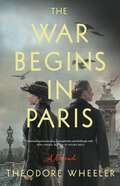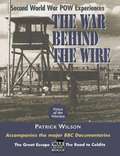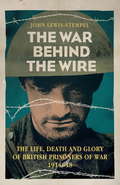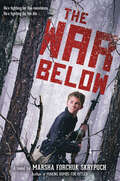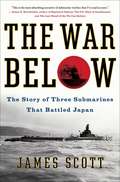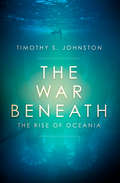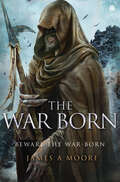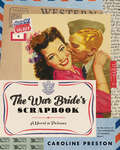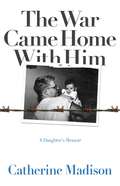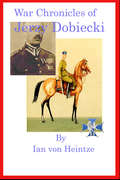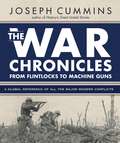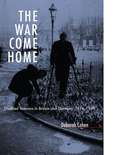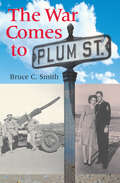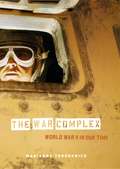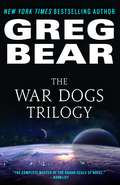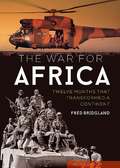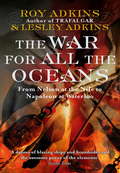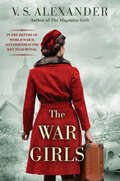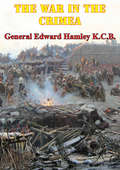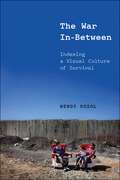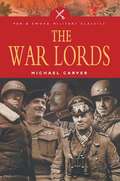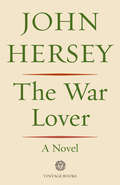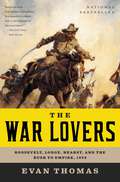- Table View
- List View
The War Begins in Paris: A Novel
by Theodore WheelerFrom the author of Kings of Broken Things and In Our Other Lives comes a "powerful, immersive" literary noir about two female World War II correspondents whose fates intertwine in Europe (Caitlin Horrocks). Paris, 1938. Two women meet: Mielle, a shy pacifist and shunned Mennonite who struggles to fit in with the elite cohort of foreign correspondents stationed around the city; the other, Jane, a brash, legendary American journalist, who is soon to become a fascist propagandist. When World War II makes landfall in the City of Lights, Mielle falls under Jane&’s spell, growing ever more intoxicated by her glamour, self-possession, and reckless confidence. But as this recklessness devolves into militarism and an utter lack of humanity, Mielle is seized by a series of visions that show her an inescapable truth: Jane Anderson must die, and Mielle must be the one to kill her. Structured as a series of dispatches filed from around Europe and based on the misadventures of a real journalist-turned-Nazi mouthpiece, The War Begins in Paris is a cat-and-mouse suspense that examines the relentlessness of propaganda, the allure of power, and how far one woman will go for the sake of her morality.
The War Behind the Wire: Second World War POW Experiences (Voices of the Veterans)
by Patrick WilsonPublished to coincide with the major 2 part BBC1 series (Autumn 2000) of the same name, War Behind the Wire focuses on the capture, interrogation, the comradeship of camp life, escape planning and forgery techniques, tunnelling, the thrill of life on the run, re-capture and punishment, the joy of liberation. All these experiences and more are vividly described by former POWs of the Second World War and their German camp guards, in War Behind the Wire.Through gripping first-hand accounts enhanced with numerous illustrations, we learn the true story of the ill-fated Great Escape, which ended in the barbaric murder of 50 gallant men of many nationalities. Former inmates tell what life in Colditz Castle was really like.War Behind the Wire is an inspiring book of memories and experiences of those who never gave up hope. These will be as unforgettable for the reader as they were for those who found themselves in captivity.
The War Behind the Wire: The Life, Death and Glory of British Prisoners of War, 1914-18
by John Lewis-StempelOn capture, British officers and men were routinely told by the Germans 'For you the war is over'. Nothing could be further from the truth. British Prisoners of War merely exchanged one barbed-wire battleground for another.In the camps the war was eternal. There was the war against the German military, fought with everything from taunting humour to outright sabotage, with a literal spanner put in the works of the factories and salt mines prisoners were forced to slave in. British PoWs also fought a valiant war against the conditions in which they were mired. They battled starvation, disease, Prussian cruelties, boredom, and their own inner demons. And, of course, they escaped. Then escaped again. No less than 29 officers at Holzminden camp in 1918 burrowed their way out via a tunnel (dug with a chisel and trowel) in the Great Escape of the Great War.It was war with heart-breaking consequences; more than 12,000 PoWs died, many of them murdered, to buried in shallow unmarked graves.Using contemporary records - from prisoners' diaries to letters home to poetry - John Lewis-Stempel reveals the death, life and, above all, the glory of Britain's warriors behind the wire. For it was in the PoW camps, far from the blasted trenches, that the true spirit of the Tommy was exemplified.
The War Below
by Marsha Forchuk SkrypuchThis companion novel to Skrypuch's Making Bombs for Hitler follows a boy who joins the underground Ukrainian resistance in the fight against Hitler.The Nazis took Luka from his home in Ukraine and forced him into a labor camp. Now, Luka has smuggled himself out -- even though he left behind his dearest friend, Lida. Someday, he vows, he'll find her again.But first, he must survive.Racing through the woods and mountains, Luka evades capture by both Nazis and Soviet agents. Though he finds some allies, he never knows who to trust. As Luka makes difficult choices in order to survive, desperate rescues and guerilla raids put him in the line of fire. Can he persevere long enough to find Lida again or make it back home where his father must be waiting for him?Marsha Forchuk Skrypuch, author of Making Bombs for Hitler, delivers another action-packed story, inspired by true events, of daring quests and the crucial decisions we make in the face of war.
The War Below: The Story of Three Submarines That Battled Japan
by James M. Scott“Beautifully researched and masterfully told” (Alex Kershaw, New York Times bestselling author of Escape from the Deep), this is the riveting story of the heroic and tragic US submarine force that helped win World War II in the Pacific.Focusing on the unique stories of three of the war’s top submarines—Silversides, Drum, and Tang—The War Below vividly re-creates the camaraderie, exhilaration, and fear of the brave volunteers who took the fight to the enemy’s coastline in World War II. Award-winning journalist James Scott recounts incredible feats of courage—from an emergency appendectomy performed with kitchen utensils to sailors’ desperate struggle to escape from a flooded submarine—as well as moments of unimaginable tragedy, including an attack on an unmarked enemy freighter carrying 1,800 American prisoners of war. The casualty rate among submariners topped that of all other military branches. The war claimed almost one out of every five submarines, and a submarine crewman was six times more likely to die than a sailor onboard a surface ship. But this valorous service accomplished its mission; Silversides, Drum, and Tang sank a combined sixty-two freighters, tankers, and transports. The Japanese were so ravaged from the loss of precious supplies that by the war’s end, pilots resorted to suicidal kamikaze missions and hungry civilians ate sawdust while warships had to drop anchor due to lack of fuel. In retaliation, the Japanese often beat, tortured, and starved captured submariners in the atrocious prisoner of war camps. Based on more than 100 interviews with submarine veterans and thousands of pages of previously unpublished letters and diaries, The War Below lets readers experience the battle for the Pacific as never before.
The War Beneath (The Rise of Oceania #1)
by Timothy S. JohnstonA Global Thriller Award–winning novel: “Fast-paced, good old-fashioned Cold War espionage set underwater in 2099, this book offers a great escape!” (The Minerva Reader). Living underwater is inherently dangerous. At any moment, a trickle of water from the bulkheads could mean immanent death. But Truman “Mac” McClusky is used to danger. He’s been out of the intelligence business for years, working the kelp farms and helping his city Trieste flourish on the shallow continental shelf just off the coast of Florida. Then his former partner shows up, steals a piece of valuable new technology and makes a mad dash into the Atlantic. Before he knows it, Mac is back in the game, chasing the spy to retrieve the tech—and teach his former friend a lesson he won’t forget. But when Mac learns the grim truth behind the theft, it plunges him into an even deadlier mission. With lethal secrets in his pocket, he needs to evade the submarines of hostile foreign powers, escape assassins, and forge through the world’s oceans at breakneck pace on a daring quest to save his city and stay alive.
The War Born: Seven Forges, Book VI
by James A MooreThe final episode from the Seven Forges series!A final battle against the Wellish Overlords for the date of the empire takes place as their army of War-Born nightmares rages across Fellein.---The Overlords have risen!They've torn apart the Wellish Steppes and raised mountains, they're fighting against the gods themselves, attacking the Daxar Taaalor and bringing the wrath of the Children of the Forges. They've turned one of the greatest sorcerers in the history of Fellein to their side and divided the council of wizards, forcing Desh Krohan into battle with old allies. The empire is at war.The Sa'ba Taalor are preparing for battle, and the Overlords have begun their own plans, raising an army of shapechangers called the War-Born to do their bidding. The armies of the Overlords are savage, they hunt, kill and eat their prey. They are endlessly hungry.The final war is on, one that will change the shape of the Fellein Empire. Even as the gods involve themselves in the final confrontations between the empire and the enemies, old and new. File Under: Fantasy [ Last Stand | The Battle Persists | Rising Enemy | Cold Front ]
The War Bride's Scrapbook: A Novel in Pictures
by Caroline PrestonA World War II love story, narrated through a new bride’s dazzling array of vintage postcards, newspaper clippings, photographs, and moreLila Jerome has never been very lucky in love, and has always been more interested in studying architecture and, more recently, supporting the war bond effort on the home front. But in the fall of 1943, a chance spark with a boarder in her apartment sets Lila on a course that shakes up all of her ideas about romance.Lila is intoxicated by Perry Weld, the charismatic army engineer who’s about to ship out to the European front, and it isn’t long before she discovers that the feeling is mutual. After just a few weeks together, caught up in the dramatic spirit of the times and with Perry’s departure date fast approaching, the two decide to elope. In a stunning kaleidoscope of vibrant ephemera, Lila boldly attempts to redefine her life in America as she navigates the heartache and longing of a marriage separated by ocean and war.In her second scrapbook novel after the lauded Scrapbook of Frankie Pratt, Caroline Preston has once again pulled from her own extraordinary collection of vintage memorabilia, transporting us back to the lively, tumultuous 1940s and introducing us to an unforgettable, ambitious heroine who must learn to reconcile a wartime marriage with a newfound self-confidence.
The War Business: The International Trade in Armaments
by George ThayerAfter the two world wars with security of individual Nations very high, a new business in armaments trade has become a routine. The U.S. government sells armaments to various countries and has become a super power. U.S.S.R. did not lag behind.
The War Came Home with Him: A Daughter's Memoir
by Catherine MadisonDuring his years as a POW in North Korea, &“Doc&” Boysen endured hardships he never intended to pass along, especially to his family. Men who refused to eat starved; his children would clean their plates. Men who were weak died; his children would develop character. They would also learn to fear their father, the hero. In a memoir at once harrowing and painfully poignant, Catherine Madison tells the stories of two survivors of one man&’s war: a father who withstood a prison camp&’s unspeakable inhumanity and a daughter who withstood the residual cruelty that came home with him.Doc Boysen died fifty years after his ordeal, his POW experience concealed to the end in a hidden cache of documents. In The War Came Home with Him, Madison pieces together the horrible tale these papers told—of a young captain in the U.S. Army Medical Corps captured in July 1950, beaten and forced to march without shoes or coat on icy trails through mountains to camps where North Korean and Chinese captors held him for more than three years. As the truth about her father&’s past unfolds, Madison returns to a childhood troubled by his secret torment to consider, in a new light, the telling moments in their complex relationship.Beginning at her father&’s deathbed, with all her questions still unspoken, and ending with their final conversation, Madison&’s dual memoir offers a powerful, intimate perspective on the suppressed grief and thwarted love that forever alter a family when a wounded soldier brings his war home.
The War Chronicles of Jerzy Dobiecki
by Ian HientzeThis tribute to the life of Jerzy Dobiecki, a Polish cavalry captain with the 18-ty Pułk Ułanów Pomorskich – the 18th Polish Pomeranian Lancers, is a story based on previously archived material, originally written by the Captain in Polish, that has been translated for the first time into English. The Captain’s chronicles bring to life eye-witness accounts of his regiment’s deployments during the Russo-Polish War between 1919 and 1921, one of several little-publicized wars in English and fought between Poland and her neighbors immediately following the 1914-1918 Great War. Eighteen years later, as Poland was invaded by Germany in September 1939, from his position on attachment to the Polish Ministry of Military Affairs in Warsaw, Captain Dobiecki kept a diary of battles as they developed across Poland during the first weeks of the Second World War. The diary records events as he, and what remained of the Polish military High Command, were evacuated to neighboring Romania when Poland was additionally overrun by Soviet forces from the east. His journal sheds light on his subsequent escape from internment across Europe to France and later on to Britain, where he served as a staff officer with the command of the Polish 1st Corps, formed in exile in Scotland. Following the end of hostilities in Europe in 1945 and upon return to Britain after the fighting on the continent, like thousands of other Poles commissioned under the auspices of the Polish Resettlement Corps, Jerzy had to decide whether to return to his native Poland or whether he should try to somehow rescue and bring to England what was left of his family – now trapped behind the iron curtain in eastern Poland, facing an uncertain future and severity under a Stalinist regime.
The War Chronicles: From Flintlocks to Machine Guns
by Joseph CumminsA Global Survey of Modern Warfare, from the First Fervid Days of the French Revolution of 1789 to the Bloody Stalemate that Ended the Iran-Iraq War in 1988.
The War Come Home: Disabled Veterans in Britain and Germany, 1914-1939
by Deborah Cohen"This impressive book offers a powerful set of insights into the lasting effects of the First World War and the different ways in which belligerent states came to terms with the war's consequences."
The War Comes to Plum Street
by Bruce C. SmithHow World War II changed New Castle, Indiana. “This is a unique look at the war, far from the front lines, but equally impacting life on the home front.” —Bookviews.comThe War Comes to Plum Street brings to life the Second World War through the eyes of a small group of neighbors from a Midwestern town. Bruce C. Smith presents their stories just as they happened, without explanation or interpretation. To experience the war as they did, insofar as it is possible, we must understand how they perceived everyday events and recognize the incompleteness of their knowledge of what was taking place in Europe and the Pacific. The inhabitants of Plum Street in New Castle, Indiana, resemble many other average Americans of their day. As we discover how they experienced those fateful years, these Americans may have something to teach us about how we live in our own turbulent time.“This remains a superb story. Bruce C. Smith has a wonderful eye for detail and a compelling perspective and voice. We care about this place and the people who live here.” —James H. Madison, author of Hoosiers: A New History of Indiana“The book is worth reading for what it offers about the emotional life of the times. Smith recognizes that in a small community and, more particularly, on a single street, lives are enmeshed . . . Ultimately, this book is deeply personal, but it reminds us that life is lived at a deeply personal level.” —HistoryNet.com
The War Complex: World War II in Our Time
by Marianna TorgovnickThe recent dedication of the World War II memorial and the sixtieth anniversary commemoration of D-Day remind us of the hold that World War II still has over America's sense of itself. But the selective process of memory has radically shaped our picture of the conflict. Why else, for instance, was a 1995 Smithsonian exhibition on Hiroshima that was to include photographs of the first atomic bomb victims, along with their testimonials, considered so controversial? And why do we so readily remember the civilian bombings of Britain but not those of Dresden, Hamburg, and Tokyo? Marianna Torgovnick argues that we have lived, since the end of World War II, under the power of a war complex--a set of repressed ideas and impulses that stems from our unresolved attitudes toward the technological acceleration of mass death. This complex has led to gaps and hesitations in public discourse about atrocities committed during the war itself. And it remains an enduring wartime consciousness, one most recently animated on September 11, 2001. Showing how different events from World War II became prominent in American cultural memory while others go forgotten or remain hidden in plain sight, "The War Complex" moves deftly from war films and historical works to television specials and popular magazines to define the image and influence of World War II in our time. Torgovnick also explores the 1961 trial of Adolf Eichmann, the emotional legacy of the Holocaust, and the treatment of World War II's missing history by writers such as W. G. Sebald to reveal the unease we feel at our dependence on those who hold the power of total war. Thinking anew, then, about how we account for war to each other andourselves, Torgovnick ultimately, and movingly, shows how these anxieties and fears have prepared us to think about 9/11 and our current war in Iraq.
The War Dogs Trilogy (War Dogs)
by Greg BearCollected in a single volume for the first time, the epic War Dogs trilogy of interstellar war from a master of science fiction.The Gurus made their presence on Earth known thirteen years ago. Providing technology and scientific insights far beyond what mankind was capable of, they became indispensable advisors and promised even more gifts that we just couldn't pass up.But they were followed by mortal enemies -- the Antagonists -- from sun to sun, planet to planet, and now the Gurus are stretched thin -- and they need humanity's help.Our first bill has come due. Skyrines like Michael Venn have been volunteered to pay the price. They face insidious enemies who were already inside the solar system, establishing a beachhead on Mars.Venn and his comrades will be lucky to make it out alive -- let alone preserve the future of all of mankind. The War Dogs TrilogyWar Dogs (HC: 10/14; TP: 07/15)Killing Titan (HC: 10/15; TP: 07/16)Take Back the Sky (HC: 12/16; TP: 07/17)
The War For Africa: Twelve Months That Transformed A Continent
by Fred BridglandThe story of the Cuban-South African war in Angola in 1987–88 through the eyes of the South Africans who fought in it. <p><p> The Angolan Civil War lasted over a quarter of a century, from 1975 to 2002. Beginning as a power struggle between two former liberation movements, the MPLA and UNITA, it became a Cold War struggle with involvement from the Soviet Union, Cuba, South Africa and the USA. <p> This book examines the height of the Cuban-South African fighting in Angola in 1987–88, when 3,000 South African soldiers and about 8,000 UNITA guerrilla fighters fought in alliance against the Cubans and the armed forces of the Marxist MPLA government, a force of over 50,000 men. Bridgland pieced together the course of the war, fought in one of the world’s most remote and wild terrains, by interviewing the South Africans who fought it, and many of their accounts are woven into the narrative. <p> This classic account of a Cold War struggle and its momentous consequences for the participants and across the continent, is released in a new edition with a new preface and epilogue.
The War For All The Oceans: From Nelson at the Nile to Napoleon at Waterloo
by Lesley Adkins Roy AdkinsAs France emerged from revolution, a young general named Napoleon Bonaparte invaded Egypt, hoping next to march overland to India. It would not happen. Britain swung her forces into action to battle for control of the world's sea-lanes and thus all international trade. The Battle of the Nile and then at Acre were the first sallies in what would be fifteen years of bitter fighting. It was a war won at sea, and by the time of Waterloo Britain had gained control and possessed the foundations of her vast empire.Brought vividly to life through the words and stories of the ordinary people caught up in the conflict, this is a sweeping history of the years of naval warfare that set the balance of power in Europe for the following century. Taking in gallant duels, bloody battles between huge fleets, amphibious assaults, daring coastal raids, and the subtleties of espionage and naval intelligence, this global conflict truly was THE WAR FOR ALL THE OCEANS.
The War Girls: A WW2 Novel of Sisterhood and Survival
by V.S. AlexanderBased on true WWII stories of life in the Warsaw Ghetto during the Occupation and the women who served the Allies as agents and spies, this new historical fiction novel from an acclaimed author is perfect for fans of Kate Quinn, Kristin Harmel, and Pam Jenoff. Casting light into one of the darkest periods of World War II, this powerful book tells of two Jewish sisters– one imprisoned in Poland and the other who joins the Special Operations Executive in a daring attempt to free her family from the Nazis. It&’s not just a thousand miles that separates Hanna Majewski from her younger sister, Stefa. There is another gulf—between the traditional Jewish ways that Hanna chose to leave behind in Warsaw, and her new, independent life in London. But as autumn of 1940 draws near, Germany begins a savage aerial bombing campaign in England, killing and displacing tens of thousands. Hanna, who narrowly escapes death, is recruited as a spy in an undercover operation that sends her back to her war-torn homeland. In Hanna&’s absence, her parents, sister, and brother have been driven from their comfortable apartment into the Warsaw Ghetto. Sealed off from the rest of the city, the Ghetto becomes a prison for nearly half a million Jews, struggling to survive amid starvation, disease, and the constant threat of deportation to Treblinka. Once a pretty and level-headed teenager, Stefa is now committed to the Jewish resistance. Together, she, Hanna, and Janka, a family friend living on the Aryan side of the city, form a trio called The War Girls. Against overwhelming odds and through heartbreak they will fight to rescue their loved ones, finding courage through sisterhood to keep hope alive . . . Praise for V.S. Alexander and The Sculptress&“Fans of Alena Dillon, Lucinda Riley, and Alexander&’s previous work will appreciate the historical accuracy saturating every page of this moving, compassionate novel.&” —Booklist
The War In The Crimea [Illustrated Edition]
by Lieutenant-General Sir Edward Bruce Hamley KCB KCMGThe finest eye-witness history of the Crimean War. Lauded at the time as the best history of the bloody and badly-led campaign, this edition has been richly illustrated with over two hundred and sixty maps, photos and portraits, of the battles, individuals and places involved in the Crimean War]General Sir Edward Hamley, K.C.B., initially served as an aide de camp to Sir Richard Dacres during the Russian War, but as his substantive rank was in the Royal Artillery he saw most of his service with the guns during the Crimean War. The Author was cited many times for his gallant conduct and bravery whilst working alongside the siege cannon in both the French and British Lines. He survived the Crimean War to become one of the figureheads of the Victorian military establishment, attaining the rank of Lieutenant General and holding the important post of the commandant of the Staff College.
The War In-Between: Indexing a Visual Culture of Survival
by Wendy KozolExplores the ambiguities and contradictions that disrupt the assumed boundaries of battle zonesAgainst the fabric of suffering that unfolds around more spectacular injuries and deaths, The War In-Between studies visual depictions of banal, routine, or inscrutable aspects of militarized violence. Spaces of the in-between are both broader and much less visible than battlefields, even though struggles for survival arise out of the same conditions of structural violence. Visual artifacts including photographs, video, data visualizations, fabric art, and craft projects provide different vantage points on the quotidian impacts of militarism, whether it is the banality of everyday violence for non-combatants or the daily struggles of soldiers living with physical and emotional trauma.Three interrelated concepts frame the book’s attempt to “stay” in the moment of looking at visual cultures of survival. First, the concept of the war in-between captures those interstitial spaces of war where violence and survival persist side-by-side. Second, this book expands the concept of indexicality to consider how images of the in-between rely on a range of indexical traces to produce alternative visualities about survival and endurance. Third, the book introduces an asymptotic analysis to explore the value in getting close to the diverse experiences that comprise the war in-between, even if the horizon line of experience is always just out of reach.Exploring the capaciousness of survival reveals that there is more to feel and engage in war images than just mangled bodies, collapsing buildings, and industrialized death. The War In-Between, Kozol argues, offers not a better truth about war but an accounting of visualities that arise at the otherwise unthinkable junction of conflict and survival.
The War Inside
by Michal ShapiraThe War Inside is a groundbreaking history of the contribution of British psychoanalysis to the making of social democracy, childhood, and the family during World War II and the postwar reconstruction. Psychoanalysts informed understandings not only of individuals, but also of broader political questions. By asserting a link between a real 'war outside' and an emotional 'war inside', psychoanalysts contributed to an increased state responsibility for citizens' mental health. They made understanding children and the mother-child relationship key to the successful creation of a democratic citizenry. Using rich archival sources, the book revises the common view of psychoanalysis as an elite discipline by taking it out of the clinic and into the war nursery, the juvenile court, the state welfare committee, and the children's hospital. It traces the work of the second generation of psychoanalysts after Freud in response to total war and explores its broad postwar effects on British society.
The War Lords: Military Commanders Of The Twentieth Century (Pen & Sword Military Classics)
by Michael CarverDetailed profiles of forty-three military commanders of the twentieth century, from Patton to Rommel, Yamamoto, and Zhukov, written by top historians. In The War Lords, Field Marshal Lord Carver has assembled an engrossing series of short, detailed biographies of forty-three of the dominant military commanders on the twentieth-century world stage, written by such prominent historians as Alistair Horne, Norman Stone, Stephen Ambrose, Lord Kinross, and Martin Middlebrook. Included are: Field-Marshal the Earl Alexander, E.H.H. Allenby, Claude Auchinleck, Field-Marshal Sir, Omar N. Bradley, General of the Army, Andrew Browne Cunningham, Admiral of the Fleet the Viscount, Karl Doenitz, Admiral, Hugh C.T. Dowding, Air Chief Marshal, Dwight D. Eisenhower, General of the Army, Ferdinand Foch, Bernard Freyberg, Lieutenant-General Lord, Heinz Guderian, General, Douglas Haig, William F. Halsey, Fleet Admiral, Ian Hamilton, Arthur Harris, Marshal of the Royal Air Force Sir, Paul von Hindenburg, John Rushworth Jellicoe, Joseph Joffre, Alphonse Juin, Marshal, Mustafa Kemal, Ivan Koniev, Marshal, Erich Ludendorff, Douglas C. MacArthur, General of the Army, John Monash, Bernard L. Montgomery, of Alamein, Louis Mountbatten, Earl of Burma, Chester W. Nimitz, Fleet Admiral, George S. Patton, General, John J. Pershing, Philippe Petain, Erwin Rommel, Field-Marshal, William Joseph Slim, Field-Marshal the Viscount, Carl A. Spaatz, General, Raymond A. Spruance, Admiral, Joseph W. Stilwell, General, Marshal of the Royal Air Force Lord Tedder, Hugh Trenchard, Erich Von Falkenhayn, Erich Von Manstein, Field Marshal, Gerd Von Rundstedt, Field-Marshal, Archibald Wavell, Field-Marshal Earl, Isoroku Yamamoto, Admiral & Georgii Zhukov, Marshal.
The War Lover: A Novel
by John HerseyIn the immediate sense, this long, eventful and agonizingly suspenseful novel shows what fear, secret hidden fear, can do to even one of those seeming heroes, a war lover. In the longer view, however, this may come to be regarded as the great and ultimate anti-war novel of our time. The scene is an American bomber base in England sometime before D-Day. The characters are the crew of a Flying Fortress named The Body, particularly the pilot, Buzz Marrow, and the co-pilot, Boman, who tells the story of his worship of Marrow, and of how his hero succumbed, on their final crucial mission, to the fatal weakness with which he camouflaged his fear—his secret delight in annihilation. Boman also tells the story of the English girl he loved (and Mr. Hersey’s many admirers will note a new tenderness and passion in these scenes), and of her fateful intervention in Marrow’s collapse. Both narrative lines flow together and are superbly united in the sustained and powerful climax.
The War Lovers: Roosevelt, Lodge, Hearst, and the Rush to Empire 1898
by Evan ThomasOn February 15th, 1898, the American ship USS Maine mysteriously exploded in the Havana Harbor. News of the blast quickly reached U.S. shores, where it was met by some not with alarm but great enthusiasm. A powerful group of war lovers agitated that the United States exert its muscle across the seas. Theodore Roosevelt and Henry Cabot Lodge were influential politicians dismayed by the "closing" of the Western frontier. William Randolph Hearst's New York Journal falsely heralded that Spain's "secret infernal machine" had destroyed the battleship as Hearst himself saw great potential in whipping Americans into a frenzy. The Maine would provide the excuse they'd been waiting for. On the other side were Roosevelt's former teacher, philosopher William James, and his friend and political ally, Thomas Reed, the powerful Speaker of the House. Both foresaw a disaster. At stake was not only sending troops to Cuba and the Philippines, Spain's sprawling colony on the other side of the world-but the friendships between these men.Now, bestselling historian Evan Thomas brings us the full story of this monumental turning point in American history. Epic in scope and revelatory in detail, The War Lovers takes us from Boston mansions to the halls of Congress to the beaches of Cuba and the jungles of the Philippines. It is landmark work with an unforgettable cast of characters--and provocative relevance to today.
